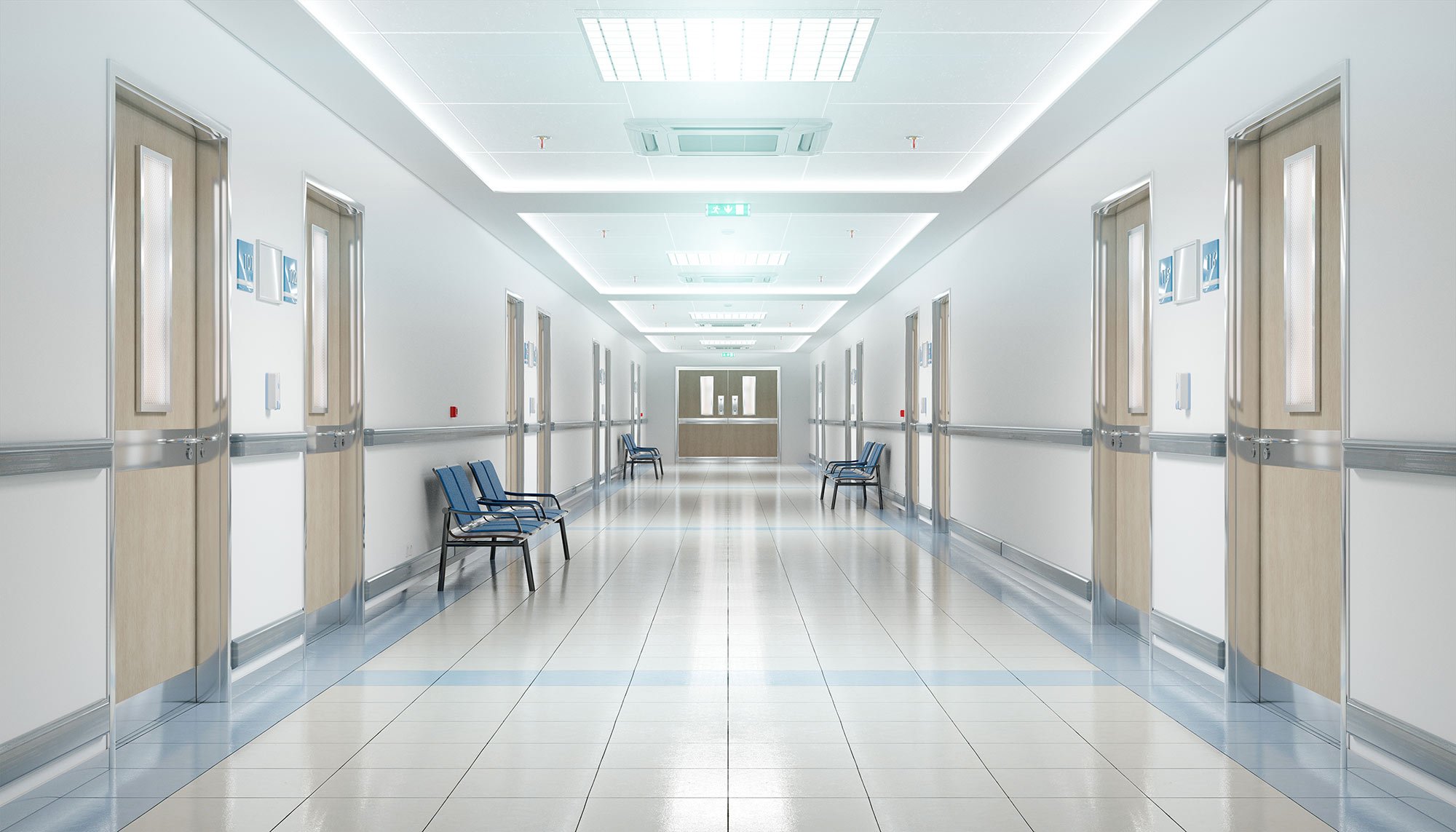While the COVID-19 pandemic has recently put hospital acquired-infections in the public eye, the airborne transmission of pathogens has impacted patient welfare since hospitals were first conceived. Despite significant advances in technology, this problem continues to afflict the healthcare industry year-on-year. Even before COVID-19, 1 in 39 patients were impacted by Healthcare Associated Infections (HAI) acquired in hospitals, and these have been estimated to cost the UK’s National Healthcare Service (NHS) over £2.1 billion per year, and the US Center for Disease Control (CDC) estimated $28.4 billion per year.
While solutions involving sanitation, personal protection, medication, and air circulation are often discussed, the role of lighting is rarely considered within mainstream discourse. But perhaps it should be. Finding a way to control the transmission of particularly virulent pathogens is an ongoing challenge, but could the answer lie in a niche, lighting technology?
The history of UVGI
UVGI (ultraviolet germicidal irradiation) is a type of electromagnetic radiation that uses short-wavelength ultraviolet emissions to deactivate viral, bacterial, and fungal organisms, preventing the spread of some infectious diseases. Ultraviolet treatment has been in use since as early as 1909, and was first deployed to cleanse water supplies. In the 1950s, the technology was introduced to the healthcare industry to sterilise equipment and surfaces. Following this, it was quickly applied to a range of other applications in the sector.
One of the most promising of these applications is the use of UVGI to treat the upper air volume of hospital rooms – which is the area situated above an occupied space. UVGI is located here to protect people from the device’s UV output. From this position, it irradiates the upper air volume to deactivate pathogens as they circulate. Owing to this capability, the World Health Organisation (WHO) has now recognised the technology as an effective mitigation measure to control the airborne transmission of tuberculosis.
Current practice in the healthcare sector focuses on improving fresh air supply rates and minimising recirculation, rather than the deployment of air cleaning technologies such as UVGI. However, an approach based on increased air changes is highly energy intensive, limited by existing equipment capacity, and may not support sustainability goals in the long term. Perhaps then, the strategic application of UVGI could offer an effective alternative for patient protection, while helping hospitals to keep pace with their net zero aims.
Modelling UVGI's impact
To understand the potential benefits of the technology, we undertook a comprehensive review of the uses and applications of UVGI emitters and developed a host of tools to determine their effectiveness in a variety of situations. These uses ranged from the direct treatment of touch surfaces within lifts, operating theatres, and lab spaces, to the continuous treatment of air in occupied spaces, such as waiting areas, consultation rooms, treatment rooms, wards, and corridors.
As part of our research, we developed advanced models to measure the performance of UVGI products. Although analytical models have been previously developed and deployed to predict the risk of airborne diseases, these models typically focus on risk reduction through increased ventilation and often assume that pathogens are evenly distributed throughout a space. Although this is a reasonable conclusion for typical rooms with ceiling mounted HVAC systems, this is not always the case for more complex spaces.
Through the collaboration of multiple disciplines, we developed a dynamic modelling system that maps how UV technology and complex airflows interact in all room types. Our specialists in lighting design, building physics, and crowd modelling worked together to create air flow models and fluence datasets that help to accurately predict the effectiveness of upper-room UVGI. This enabled us to model the circulation of exhaled breath from occupants as it moves within ventilation air currents through the UV field. Our dynamic modelling system also allowed us to account for spatial variations in footfall throughout a hospital’s diverse range of rooms, spaces, and winding corridors.
With this approach, we can provide critical insights for understanding the performance of UVGI installations in different situations and locations. These can then be fed back into hospital designs, which helps to make safer medical facilities for everyone.
Determining UVGI's effectiveness
Despite eight decades of peer-reviewed scientific research supporting UVGI’s ability to disinfect airstreams, there remains uncertainty within the healthcare sector regarding the technology’s effectiveness. This is because UVGI for upper air volumes has only recently been standardised in certain countries and remains relatively unknown on a global scale. However, our research has found that UVGI reliably deactivates pathogens in the air, while reducing the density of active viral pathogens across applications, including in hospital spaces. Our work supports previous academic research on upper-room UVGI, which has revealed that it can be as effective as six to ten air changes per hour in reducing the transmission of tuberculosis.
Consequently, UVGI not only complements existing transmission mitigation methods, but could also help to reduce the load on air handling systems. These HVAC systems are known to have high energy consumption rates, and UVGI has the potential to minimise energy use by reducing the number of air changes that hospitals need to perform per hour.
This decreases the energy consumption of hospitals, lessening their carbon footprint.
In line with this, Arup supported the global healthcare NGO, Healthcare Without Harm, with producing a road map that outlines the actions required by the sector to reach net zero by 2050. This collaboration found that healthcare contributes to 4.4% of all global emissions – positioning healthcare as the fifth largest climate polluter if it were a country.
In this road map, the operation of healthcare buildings was identified as a leading factor that needs to be addressed. With air circulation being listed as a major cause of energy use in healthcare buildings, UVGI’s potential impact on air treatment strategies could play an important role in reducing the sector’s carbon emissions.
COVID-19, UVGI, and the future of healthcare
In addition to minimising the spread of long-established infections, studies have also shown that UVGI can deactivate COVID-19 pathogens (SARS-CoV-2). The virus is now widely considered to be transmitted through aerosolised droplets, and this works to the advantage of upper-room UVGI. Operating close to the source of contamination, this technology continuously disinfects air within the upper areas of rooms – rather than exclusively during cleaning cycles. This can significantly reduce the risk of transmission via aerosolised droplets.
The global pandemic has also coincided with the emergence of next generation UVGI equipment – such as far-UVC – which has the potential to further increase safety and efficiency. Far-UVC uses shorter wave lengths which enables it to irradiate a whole room rather than just its upper air volumes – without harming occupants. This allows far-UVC to be even more effective and efficient as a method of patient and staff protection.
As a result, UVGI and its next generation iterations are not only important tools for impeding the spread of current infections such as COVID-19, but also offers protection from pathogens that we have not yet encountered. With the WHO reporting a 10% increase in detected cases of MDR-tuberculosis between 2018 and 2019, new strains of multi-drug resistant pathogens are evolving rapidly within our hospital walls, and these are continuing to place patients in harm’s way. Through the mass-adoption of UVGI across the world’s healthcare facilities, we can minimise the transmission of infections between patients; helping them to feel safe and secure about their next visit to the hospital.
Learn more
-
Expertise
Lighting design
We take a 24-hour approach to designing with light, producing beautiful and sustainable designs at any scale or in any context. How we experience and interact with light is central to our creative process. Whether it working on an interior space or exterior, our lighting designers and advisors integrate both daylight and architectural lighting in harmony.
-
Expertise
Building physics
 ;
;

